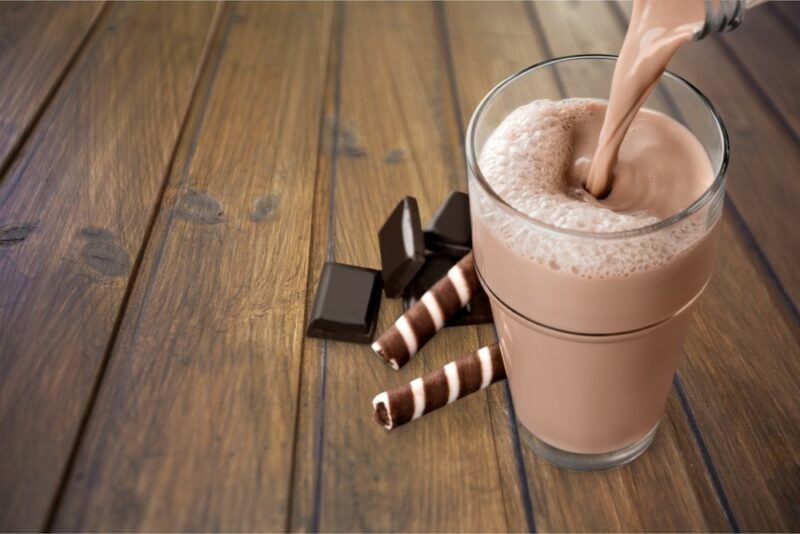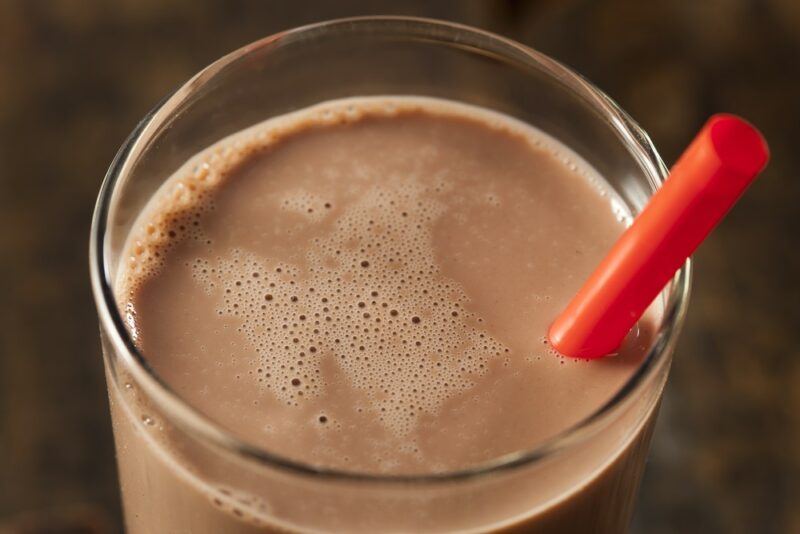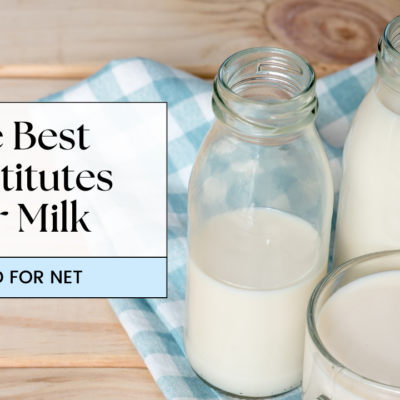
Chocolate milk is a popular treat among kids, and some adults, but it’s hardly what you’d call a health food. Or, is it? You may have heard some claims to the contrary, like the idea that chocolate milk can help with recovery after exercise. Let’s take a look then. Is chocolate milk good for you?
The first thing to remember is that context matters. A glass of chocolate milk after intense exercise isn’t the same as drinking multiple glasses of chocolate milk instead of water each day. The first approach may provide benefits. The second will probably lead to diabetes instead.
A similar pattern is true for most foods and drinks, even those that are famous for their health benefits, like chia seeds and avocados. To see the most benefits, you need to be wise about when you use chocolate milk and the amount that you have.
Is Chocolate Milk Good For You?
- What Is Chocolate Milk?
- Benefits Of Chocolate Milk
- The Problems With Chocolate Milk
- Should You Drink Chocolate Milk Anyway?
- Chocolate Milk Versus White Milk
- What About Plant-Based Chocolate Milk?
- Final Thoughts
What Is Chocolate Milk?
Chocolate milk is, quite simply, chocolate flavored milk – one that’s often sweetened as well. Preparing it is as simple as mixing regular cow’s milk with chocolate powder or chocolate syrup.
That much is pretty obvious. You’ve probably bought chocolate milk from the store plenty of times and perhaps made it at home too.
However, chocolate milk isn’t all the same.
The first difference is the type of milk used. Many chocolate milk products use 1% milk or fat free milk, which keeps the fat content down. However, you can find chocolate milk made with full fat milk instead. This tends to be even creamier and seems even more decadent.
Some types of chocolate milk skip dairy altogether and rely on plant-based milk. We’ll talk about those later. For now, let’s focus on regular chocolate milk.
Even if you stick to the same type of chocolate milk, like 1% or 2%, there’s a lot of variation in the nutritional profile.
Some products are extremely sweet, like Nesquik Chocolate Lowfat Milk, where you may be getting around 22 grams of sugar per serving. That product contains additives too, including artificial flavors, carrageenan, and cellulose gum.
Fairlife Low Fat Chocolate Milk, on the other hand, keeps the sugar content low, while providing more protein and calcium at the same time. However, the company uses artificial sweeteners, so the chocolate milk isn’t as wonderful as it first appears.
Such differences show why it’s so important to shop around and choose reliable brands.
Benefits Of Chocolate Milk

Provides Many Nutrients
Like regular milk, chocolate milk provides various important vitamins and minerals. Calcium is easily the most well-known. This mineral is associated with bone development, as well as blood clotting, and muscle function.
Milk is often fortified with vitamin D, so you’ll find this vitamin in many chocolate milk products too. Vitamin D may be even more crucial than calcium, simply because many of us aren’t getting enough of it.
Interestingly, vitamin D helps your bones to absorb calcium. This activity makes food that contains both vitamin D and calcium especially powerful.
Vitamin D and calcium are just two of the nutrients present. There are plenty of others too, including potassium, iron, vitamin A, vitamin B12, zinc, and magnesium.
The Protein Content
There’s some protein present as well. The benefits of protein are pretty famous by this point, as protein is used throughout your body. It’s particularly relevant for keeping you satisfied and helping to build muscles.
Dairy products are particularly relevant for your muscles, as they offer whey and casein protein. Both protein types are exceptional, offering the amino acids that you need.
A key difference is that whey tends to be broken down quickly, while casein takes longer. While whey is often seen as superior, the truth is that both types have their advantages. As such, getting whey and casein in the same drink is ideal for your muscles.
The protein content of milk isn’t exceptionally high (you’ll get more from protein shakes), but this isn’t really a bad thing. Few of us really 20 or 30 grams of protein per serving. The 8 grams or so that you get in a glass of milk could be just the right amount.
Can Help With Workout Recovery

Have you ever seen people drink chocolate milk after exercise? The practice is particularly common for young athletes. Their coach may get them to drink chocolate milk straight after an intense session or before going home for the day.
Doing so isn’t just a reward. The chocolate milk may help their bodies to recover from the exercise, as it contains quality protein that promotes muscle repair and recovery. Milk is hydrating as well and contains plenty of nutrients.
Even the sugar in chocolate milk is helpful, as it helps to provide an energy boost, one that’s often needed after intense exercise. Indeed, getting some energy back after exercise is incredibly important.
May Be Better Than Recovery Drinks
Chocolate milk might seem like an odd exercise recovery choice, given that there are so many specialized products on the market. Despite this, chocolate milk has some advantages, particularly for kids.
The first is price. A bottle of chocolate milk is much less expensive than a specialized workout recovery drink or powder.
Then there are the ingredients. Workout recovery products are often packed with ingredients that might help your recovery, like various herbal extracts, caffeine, amino acids, and the like. Such compounds are rarely a good choice for kids.
Even adults may benefit from sticking to the simple ingredients in chocolate milk, rather than relying on workout formulas. After all, if you don’t need the extra ingredients, why put them in your body? You can’t be entirely certain of their health impacts.
Finally, there’s the flavor.
Workout recovery drinks are always hit and miss when it comes to flavor. It takes time to find a good one and even then, the taste and texture often vary from one batch to the next. Even low-quality chocolate milk often tastes better than a workout drink.
Besides, most kids already love chocolate milk. It should be a sinch to get them to drink a glass of it after their exercise.
The Problems With Chocolate Milk

The Sugar Content
Chocolate milk contains natural sugar from the milk, along with some added sugar. The amount of extra sugar depends on the brand. The Nesquik product we highlighted earlier, for example, contains 21 grams of natural sugars and 18 grams of added sugars.
That’s a lot of sugar – and many of us already consume more sugar than we should.
This is an important area to talk about, as high sugar intake has been linked to many problems. It can increase the risk of health conditions like type 2 diabetes and obesity, while also increasing your inflammation.
Some companies do keep the sugar content much lower, like Fairlife, which only relies on natural sugar from the milk. However, such companies may use an alternative sweeteners instead (sucralose, in the case of Fairlife). Artificial sweeteners are controversial, with many people feeling that using them regularly might put you at risk.
Personally, I prefer chocolate milk that is sweetened only with natural sugar.
May Be Additives
As we mentioned earlier, some chocolate milk products use additives. These often help with the flavor, color, and shelf stability of the drink. While these additives are all considered to be safe, they do make the drink much less natural than it could be. Some are also concerning.
Take carrageenan as an example. This food additive comes from red seaweed. It helps to thicken and preserve foods, which is why it is so popular as an additive.
Carrageenan is also incredibly controversial. There are concerns that it promotes inflammation, is bad for your digestion, and could increase the risk of some health conditions, including cancer.
Whether carrageenan is actually dangerous remains to be seen. Still, why risk it? Carrageenan is hardly an essential ingredient. Plenty of chocolate milk products don’t use carrageenan at all.
Similar patterns are true for other food additives, including artificial flavors. To stay healthy, why not skip the ultra-processed versions of chocolate milk? Look for authentic products instead. These might be more expensive, but at least you can be confident about what you’re drinking.
The Labels Can Be Misleading
Here’s something else interesting – chocolate milk isn’t always what the label suggests. Take Yoo-hoo Chocolate Drink as an example. That product can’t even legally be called chocolate milk, as it doesn’t contain milk at all.
Then there are products like Fairlife Chocolate Milk, which is delicious but has also been ultra-filtered. The increased filtration gives the chocolate milk more protein and calcium, and less sugar.
Fairlife’s approach works well. There’s no doubt about that. Still, it’s not that helpful if you’re specifically wanting a drink with everything you find in real milk.
It’s Easy To Drink Too Much

Chocolate milk suffers from the same problem as fruit juice – it’s easy to overdo it. After all, we’re talking about a sweet and delicious drink, one that’s often very refreshing. It’s easy to find yourself reaching for a second glass or even a third.
Because chocolate milk is pretty high in sugar and calories, drinking too much could easily be an issue.
The best way around this is to portion out chocolate milk carefully and don’t allow your kids, or yourself, to go back for seconds. Also think about how often you serve chocolate milk. It’s a delicious drink, sure, but it’s still sugary.
Unless you’re using chocolate milk to recover from exercise, it may be helpful to see the milk as a delicious treat – rather than as a healthy drink. This should help with your portion sizes and how often you drink chocolate milk.
Should You Drink Milk Anyway?
You may have noticed that we’ve avoided talking much about milk itself. That’s partly because we’ve covered the topic elsewhere and also because there are so many angles to consider.
On one hand, milk contains many nutrients, along with some protein. It’s often thought to help with bone health, partly because of the calcium. Indeed, milk has been touted as being healthy and essential for decades.
Milk does contain some saturated fat, but you can choose low fat milk to keep the fat and saturated fat levels down.
On the other hand, there are concerns that milk might cause inflammation, it contains some natural sugar and fat, some people can’t fully digest lactose, and all of the nutrients can be found elsewhere.
Whether milk is a good choice or a poor one ends up being a personal decision.
How do the benefits and risks balance out to you? Many people find that milk has plenty going for it and few risks. Others avoid it entirely. The choice is yours.
Consider Lactose Free Milk
If you’re mostly worried about lactose side effects, then lactose free milk is an interesting alternative. This is often created by adding the enzyme lactase to regular cow’s milk. Doing so breaks down the lactose – a similar reaction to what happens when humans digest lactose.
Because the lactose is broken down in the milk itself, people with lactose intolerance can drink it without side effects. Plus, you’re still drinking cow’s milk, so you get the same nutrients as in the non lactose free version.
Lactose free products can now be found for most types of milk, including chocolate milk. You can also look for lactase supplements. Some types can be added to milk to make it lactose free.
Chocolate Milk Versus White Milk
Most of the benefits and risks we’ve discussed are true for regular milk and chocolate milk. Both types contain roughly the same vitamins, minerals, and protein.
One difference is that chocolate milk tends to be more heavily sweetened – often containing between 11 and 17 grams of added sugar. That extra sugar makes chocolate milk seem like the worse choice of the two. Whether this is the case depends on the context.
If you’re using milk as a regular drink or an after-school treat then, yes, white milk is clearly the healthier choice. It’s less processed, tends to contain fewer additives, and is lower in sugar.
If you’re using chocolate milk to recover from exercise, the equation is a little different. In this situation, the extra sugar might be perfect – as you’re often looking for a ratio of 3:1 or 4:1 carbohydrate to protein.
What About Plant-Based Chocolate Milk?

This discussion has focused on dairy-based chocolate milk, but that isn’t your only option. You can also make or buy chocolate milk that relies on plant-based milk instead – like chocolate almond milk or chocolate coconut milk.
Not surprisingly, the nutritional profile varies depending on the type of milk that is used.
Almond milk, for example, is relatively low in nutrients and calories (unless fortified), as it mostly consists of water. Coconut milk tends to offer more nutrients, while also being creamier and higher in fat.
Plant-based milks generally contain fewer nutrients than dairy milk, so you won’t see all of the same benefits from plant-based chocolate milk. They’re often lower in protein as well. To get around this, you might need to have a handful of nuts or something similar at the same time as the chocolate milk.
Still, plant-based chocolate milk does some advantages. For example, plant-based products are often lower in saturated fat and calories than dairy milk. They don’t contain lactose either.
Final Thoughts
Most of the time, chocolate milk is a sweet and delicious drink that’s fine every so often, but certainly isn’t a health food. After rigorous exercise, the sweet drink takes on a whole new meaning, as the balance of sugar to protein makes it an ideal choice for recovery.
Of course, the type of chocolate milk you choose will make a difference too.
Look for brands that don’t add too much extra sugar into the mix, preferably ones that don’t rely on additives. If you can’t find a good product, why not make your own chocolate milk by using some high-quality cocoa powder, sweetener, and regular milk? This way you can control the sweetness and flavor yourself.
The fat content is worth considering too.
Low fat milk may be best, as this keeps the saturated fat content as low as possible. But, full fat milk mightn’t be as unhealthy as it seems. Besides, if the fat content is too low, the milk just ends up being watery. You’ll need to decide what matters the most to you – flavor or fat content.
Frequently Asked Questions
Does Chocolate Milk Have Caffeine?
Cocoa beans naturally contain caffeine, so any chocolate-based product is going to have some caffeine as well. This isn’t something to be worried about though – as the amounts are incredibly tiny.
In fact, you’re often looking at around 2 mg to 6 mg of caffeine in an 8-ounce serving. That’s similar to what you get in a cup of decaf coffee. The same amount of cola offers around 22 mg, while a cup of coffee can easily contain 90 mg of caffeine.
While parents should be cautious with the amount of caffeine kids consume, 2 mg in a glass of chocolate milk won’t have much effect at all. Even highly caffeine sensitive adults wouldn’t notice an effect.
Is Chocolate Milk Good For Kids?
Most of the benefits we’ve talked about today relate to two main areas – the benefits of milk itself and how chocolate milk can be helpful as a post workout drink.
If you’re working out, then the extra sugar and calories in chocolate milk can be helpful. The same isn’t true for kids who are using chocolate milk as an enjoyable drink.
The best way around this is to make chocolate milk from regular milk at home. You can easily get the chocolate flavor with cocoa powder and then just add a little extra sweetness if it’s needed. Doing so allows you to closely control the calorie content.
Whether chocolate milk is a good idea really depends on your situation. For example, kids that are very active and don’t like drinking regular milk could easily benefit from chocolate milk, especially as they’d burn off the extra calories anyway. In contrast, kids who are less active and already get the nutrition they need might see more benefits from simply drinking water.
How Many Calories In Chocolate Milk?
The calorie content heavily depends on the brand, as some companies add many more sweeteners than others. Still, you’re often looking at between 180 and 211 for a cup of chocolate milk. Low fat chocolate milk may have fewer calories, but only if there isn’t too much added sugar.
Is Chocolate Milk Good Before Bed?
Milk is often considered an ideal drink before bed, as it’s meant to help you calm down and sleep easier (perhaps because of the calcium and tryptophan). Chocolate milk could have the same effect, right?
Actually, there are a few problems with that idea.
The first is that chocolate milk has extra sugar and a touch of caffeine. The caffeine isn’t likely to have much impact, but the sugar could easily be an issue for sleep.
Second, there’s no evidence that anything in milk helps with sleep anyway. The sleepy effect we get from milk, particularly warmed milk, may simply be association. So, if you were given warmed milk before bed as a child, the familiarity of that routine should still help you to fall asleep.
Is Chocolate Milk Good In Coffee?
Why stick with regular milk when you can use chocolate milk instead? Many people find that chocolate milk works well with coffee, giving you creaminess, a chocolate flavor, and some sweetness. You might need a little extra sweetener too, depending on your palate.
Using chocolate milk with cold brew or iced coffee seems to be the ideal way to go. Sure, you can use chocolate milk in hot coffee too, but the flavors are so much better with cold coffee instead.

















 15 Best Vegetables to Ferment with Tips on How to Ace a Good Fermentation
15 Best Vegetables to Ferment with Tips on How to Ace a Good Fermentation
Leave a Reply